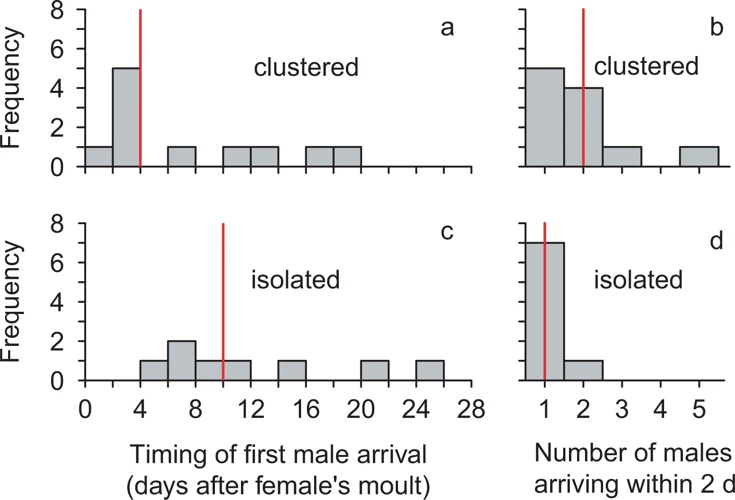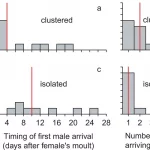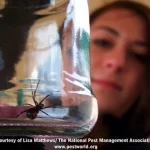The world of spiders never fails to amaze us with its intricate complexities and peculiarities. One species that stands out in this regard is the black widow spider. Championing its notoriety for its venomous bite, the black widow spider also has a unique life cycle and mating behavior that sets it apart from other spiders. This article delves into a comparative study of maturation in male and female black widow spiders, exploring the stages of their life cycle, their sexual maturation process, mating behaviors, reproduction and fecundity, and the effect of environmental factors on their maturation. So, let’s get entangled in the web of knowledge and explore this fascinating species of spiders.
Life Cycle of Black Widow Spiders

During their life cycle, black widow spiders undergo various stages of growth and maturation which are critical for their survival and reproduction. Understanding the biology of these spiders, especially their sexual maturation, can help in the development of effective pest control strategies. In this section, we will explore the different stages of the life cycle of black widow spiders, shedding light on aspects such as molting and mortality rates. We will also examine the factors that affect the maturation of these spiders, including hormonal changes and environmental conditions such as temperature and humidity. Stay tuned to discover more about the fascinating world of black widow spiders. To learn more about the maturation rate of black widow spiders, you can follow this link.
Overview of Black Widow Spiders
Black Widow Spiders (Latrodectus spp.) are known for their distinctive appearance, venomous bite, and behavior. They belong to the family of comb-footed spiders (Theridiidae). Their body length ranges from 3mm to 40mm, with females being larger than males. The male Black Widow Spider is usually half the size of the female and has a different appearance. Although there are several species of Black Widow Spiders, the most commonly known is the Southern Black Widow (Latrodectus mactans).
Black Widow Spiders are found in all the continents except for Antarctica. They are mostly found in temperate and tropical regions. These spiders prefer dark and secluded areas to build their webs. They are commonly found in crevices and corners of buildings, garages, basements, and other man-made structures. They can also be found in natural environments, such as in leaf litter, under stones, and in hollow tree trunks.
Black Widow Spiders are venomous, and their bite can cause severe pain, muscle spasms, and nausea. However, only the bite of a female Black Widow Spider is dangerous to humans. Male Black Widow Spiders do not have venom that is harmful to humans. In fact, male Black Widow Spiders are not considered a threat to humans at all.
The table below summarizes some key features of Black Widow Spiders:
| Feature | Description |
|---|---|
| Body size | 3-40mm |
| Body color | Usually black, sometimes brown or gray |
| Abdomen shape | Globular or egg-shaped |
| Web shape | Messy, irregular webs |
| Venom toxicity | Highly toxic to insects, moderately toxic to humans |
Understanding the features of Black Widow Spiders is crucial for any study or analysis related to their life cycle and behavior.
Stages of Life Cycle
During the life cycle of black widow spiders, they go through several stages of development, each of which is critical to their survival and overall reproductive success. These stages can be broadly categorized into four distinct phases: egg, larva, juvenile, and adult.
The egg stage begins with the fertilization of the female’s eggs by the male’s sperm. Black widow spiders are oviparous, which means that they reproduce by laying eggs. After fertilization, the female spider will spin a silken cocoon around the eggs, protecting them from predators and harsh environmental conditions. The incubation period can last from 10 to 30 days, depending on the environmental conditions.
Once the eggs hatch, the spiderlings enter the larval stage. The spiderlings emerge from their cocoon and will molt several times to shed their skin and grow. During this stage, they are extremely vulnerable to predators and harsh environmental conditions, and their mortality rate is quite high.
As the spiderlings continue to grow, they enter the juvenile stage. During this stage, they become more independent and start to hunt for themselves. They also continue to molt and shed their skin, and their physiology starts to resemble that of an adult spider.
Finally, the black widow spider reaches adulthood – the last stage of its life cycle. At this stage, the spider is sexually mature and is ready to mate and reproduce. Adult spiders continue to molt periodically throughout their lives, shedding their skin and developing new exoskeletons.
It’s important to note that the length of each stage in a black widow spider’s life cycle can vary depending on several factors, including temperature, food availability, and humidity. As such, the survival and maturation of black widow spiders can be affected by several environmental factors, as discussed in more detail below.
Table:
| Stage of Life Cycle | Description |
|---|---|
| Egg | The egg stage begins with fertilization and lasts 10 to 30 days. |
| Larva | The spiderlings hatch from the eggs and molt several times to shed their skin and grow. |
| Juvenile | As the spiderlings continue to grow, they become more independent and resemble adult spiders more closely. |
| Adult | Once the spider reaches adulthood, it is sexually mature and ready to mate and reproduce. |
The life cycle of black widow spiders is complex and includes multiple stages that are critical to the spider’s survival and reproductive success. Although each stage has its unique challenges and risks, the overall maturation of black widow spiders can be significantly affected by various environmental factors, some of which are described in more detail in subsequent sections of this article.
Sexual Maturation
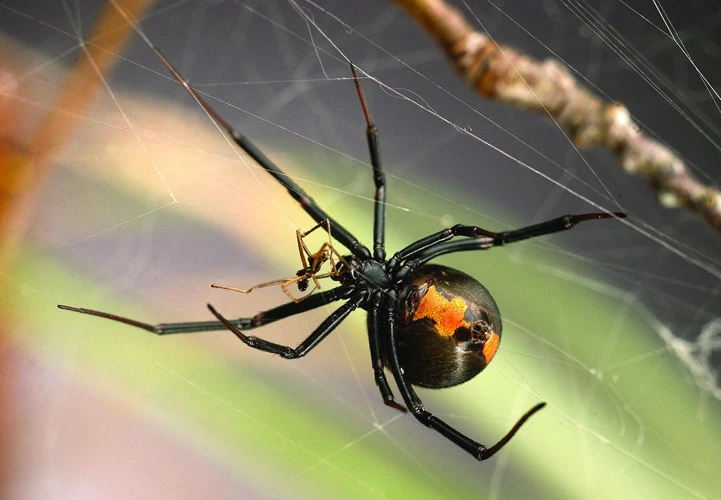
As black widow spiders progress through each stage of their life cycle, they eventually reach a crucial phase known as sexual maturation. This is the point at which males and females develop the reproductive systems necessary for mating and reproduction. Understanding the unique processes and differences in maturation between male and female black widow spiders is essential for comprehending the overall reproductive behavior and success of these predatory arachnids. In this section, we will explore the intricate details of the maturation process in both male and female black widow spiders and the factors that can contribute to the risk of maturation.
Male Maturation Process
During the male maturation process, young male black widow spiders go through several molts, shedding their exoskeletons to grow and develop. Male black widow spiders can mature in as little as 70 days, with each molt taking around 10-12 days. The male spider will move through four different stages before reaching sexual maturity.
The first stage is the egg stage, followed by the larval stage where the spider hatches and starts feeding and growing. The third stage is the juvenile stage, where the spider becomes sexually immature, but still continues to molt and grow. The fourth stage is the adult stage, in which the spider reaches sexual maturity and is ready to mate.
Males are usually smaller in size compared to females and have shorter lifespan. They also tend to have less frequent feeding habits than females.
The male black widow spider’s ultimate goal is to find a female to mate with, and as such, they may face higher mortality rates as they move towards maturity, as they may encounter aggressive females who may view them as prey instead of potential mates. According to one study, the age-specific mortality rate for male black widow spiders increases as they move towards maturity, with males having a threshold mortality rate at around four months of age.
The male maturation process in black widow spiders is an essential part of their life cycle to ensure their species’ survival through successful reproduction.
Female Maturation Process
Female maturation process in black widow spiders is a complex process that involves several consecutive stages. It starts from the juvenile phase and culminates in adulthood. The process of female maturation and development is very important for the reproduction of the species.
During the maturation process, female black widow spiders undergo a series of molts (or ecdysis) in which they shed their exoskeleton to grow. This process can happen multiple times during the spider’s life cycle to enable growth and development. Typically, female black widow spiders reach maturity after the third to fifth instar.
The Table Below Provides an Overview of the Female Black Widow Spider Maturation Process:
| Stage | Description |
|---|---|
| Juvenile phase | This is the early stage of the spider’s life, where it hatches from the egg sac and undergoes its first molt. During this phase, the spider mainly feeds on small prey and grows rapidly through successive molts. |
| Adolescent phase | After passing the juvenile stage, the spider enters the adolescent stage, also known as the subadult stage. During this phase, the spider undergoes a few more molts to reach sexual maturity. |
| Adult phase | At this stage, the spider is sexually mature and ready for reproduction. The female black widow spider produces pheromones and builds webs to attract male spiders for mating. After the successful mating, the female spider lays eggs to continue the life cycle. |
The duration of the female maturation process in black widow spiders varies depending on different environmental conditions, such as temperature, humidity, and food availability. These factors affect the spider’s growth rate and development.
According to a study on threshold mortality rate of black widow spiders, female spiders that mature faster have a higher probability of survival compared to those that develop more slowly. The researchers suggest that this is due to the reduced exposure to environmental hazards and predators.
The female maturation process in black widow spiders is crucial for their survival and the continuation of their species. The process is impacted by various environmental factors, and faster development can increase the probability of survival, according to various studies on black widow spiders.
Mating Behaviors
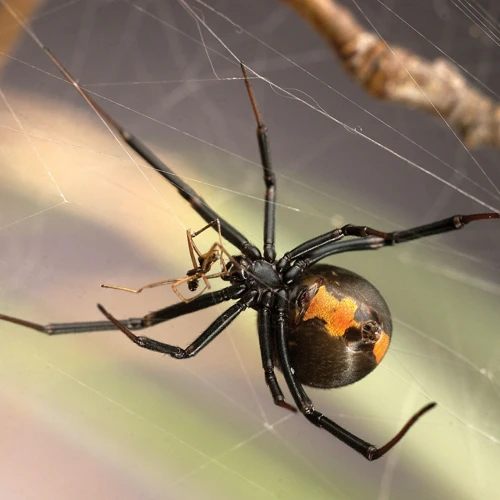
One of the most intriguing aspects of the Black Widow Spider’s life cycle is its complex mating behavior. Male and female Black Widows have evolved specific rituals to participate in before copulation can occur. Interestingly, these rituals are often associated with pre-mating cannibalism, which makes the process even more perplexing. In this section, we will discuss the different mating behaviors observed in Black Widows and explore some of the explanations behind these curious practices. Additionally, we will examine the impact of environmental factors such as temperature and food availability on Black Widow Spider mating patterns.
Mating Rituals
When it comes to mating rituals, black widow spiders have quite a unique and complex process. The males must first locate a female’s web by sensing pheromones that she has produced. Once the male spider finds a potential mate, he will approach her cautiously and begin courtship rituals to try to win her over. These rituals usually involve waving his front legs and abdomen in a specific pattern and tapping his legs on the web.
If the female is receptive, she will allow the male to approach her and begin mating. However, if she is not interested in mating or feels threatened, she may attack and attempt to kill the male. This is known as pre-mating cannibalism and is a common occurrence in black widow spider mating.
During copulation, the male spider will use his pedipalps to deposit sperm into the female’s reproductive organs. This process can take anywhere from several minutes to several hours. After mating is complete, the male will usually quickly leave the female’s web to avoid being eaten.
It’s important to note that male black widow spiders take a significant risk when approaching a female for mating. Because the female is much larger and more aggressive than the male, he has a high chance of being attacked and killed in the process. This risk increases as the male spider reaches sexual maturity, making it a dangerous time in their life cycle.
It’s also interesting to note that inter-species comparison of maturation in black widow spiders has revealed differences in the mating rituals between different species. For example, in some species of black widow spiders, the males will vibrate their bodies in a specific pattern to signal their interest to the female. In others, the males will offer the female a prey item as a gift before proceeding with courtship.
Understanding the mating rituals of black widow spiders can help researchers in their studies of the spiders’ life cycles and behavior. If you want to learn more about black widow spiders’ maturation, you can check out some other relevant topics like black widow spider maturity or inter-species comparison of maturation in black widow spiders.
Pre-Mating Cannibalism
One of the fascinating and unique aspects of Black Widow Spider mating behavior is pre-mating cannibalism, where the female often eats the male before, during, or after mating. This grisly behavior is thought to have evolved for several reasons, including providing the female with much-needed nutrition and reducing the competition for mates.
Despite the gruesome nature of this behavior, it is not always a likely outcome of the mating process. In fact, pre-mating cannibalism rates can vary depending on a variety of factors, including the age, size, and hunger levels of the female. One study found that larger females were more likely to cannibalize their mates, while another study found that younger females who had recently molted were more likely to do so.
Interestingly, some male Black Widow Spiders have developed strategies to avoid being cannibalized or to minimize the chances of harm during copulation. For example, males may approach females slowly or offer them food as a distraction, possibly increasing their chances of successful mating. Additionally, males may try to mate with multiple females to increase their chances of successful reproduction, rather than putting all their eggs in one basket (so to speak).
Pre-mating cannibalism is just one of the fascinating aspects of Black Widow Spider mating behavior that scientists continue to study and explore. While it might seem morbid or gruesome to some, it is an important part of the way these remarkable spiders reproduce, survive, and thrive in their environments.
Mating Duration and Frequency
Male and female black widow spiders have highly specific mating behaviors. Mating can even be deadly for the male black widow, as the female has been known to cannibalize her mate during or after copulation. Mating duration and frequency can also vary between male and female black widows.
Male Mating Duration and Frequency
Male black widows typically have a shorter mating duration and less frequent mating than females. Males often die shortly after mating, which limits the number of times they can mate. Additionally, male black widows often have to search for a receptive female, as females are known to be aggressive and territorial.
Female Mating Duration and Frequency
Females, on the other hand, can mate multiple times throughout their lifespan. Mating duration for females can range from a few minutes to several hours. Female black widows also have the ability to store sperm in their spermathecae for later use, meaning they do not have to mate every time they lay eggs.
Below is a table summarizing the differences in mating duration and frequency between male and female black widows:
| Mating Behavior | Male Black Widow | Female Black Widow |
|---|---|---|
| Mating Duration | Shorter | Varies, can be several hours |
| Mating Frequency | Less frequent due to high mortality rate | Multiple times throughout lifespan; ability to store sperm |
Although male and female black widows have different mating behaviors, both play a crucial role in ensuring the survival and continuation of their species. To learn more about the effect of environmental factors on maturation in black widow spiders, check out our article on environmental conditions and maturation in black widow spiders.
Reproduction and Fecundity
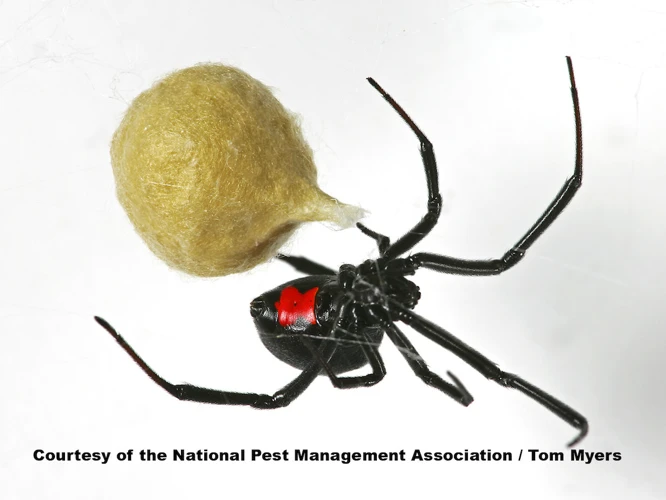
The process of reproduction and fecundity in Black Widow Spiders is a complex and intriguing topic. It is fascinating to explore how male and female spiders exhibit unique reproductive behaviors and systems. Understanding their mating rituals, reproductive organs, and fecundity can shed light on the survival and proliferation of these species. In this section, we will delve into the reproductive processes of Black Widow Spiders and uncover the mysteries behind their fecundity. We will take a closer look at the male and female reproductive systems, as well as the factors that affect their maturation, such as hormones, age-specific mortality rate, and maturation risks. By the end of this section, readers will gain a deeper understanding of how Black Widow Spiders reproduce and how their fecundity is influenced by environmental factors. To further understand the development of Black Widow Spiders, you may want to read about molting processes of Black Widow Spiders, the threshold mortality rate of Black Widow Spiders or see how the maturation of female spiders affects their behavior.
Female Reproductive System
The reproductive system of female Black Widow spiders is a complex network of organs designed to produce and maintain their young. Once matured, the female spiders are capable of producing up to nine egg sacs, each containing an average of 100-400 eggs.
The primary reproductive organ in female Black Widow spiders is the ovary, which consists of multiple tubular structures called ovarioles. Each ovariole is responsible for producing a single egg. Once the egg has been produced, it passes through the oviduct, where it is fertilized by the male’s sperm. The fertilized eggs are then stored in the uterus until they are ready to be laid.
During copulation, the male transfers his sperm to the female using specialized structures called pedipalps. The sperm are then stored in the female’s spermathecae, which are paired sac-like structures located at the base of the ovaries. The spermathecae can store sperm for several months, allowing the female to fertilize her eggs as she produces them.
However, the Black Widow spider’s reproductive success is not without risk. The male Black Widow faces a high risk of death during the mating process due to post-copulatory sexual cannibalism. This is when the female spider, hungry from not having eaten prior to copulation, attacks and kills the male after copulation. To minimize this risk, males have developed strategies such as using pheromones to signal their potential mates that they are a worthy partner.
The risk is even higher for female Black Widows as they must protect their eggs and young. Young spiders face a high mortality rate as they are often cannibalized by their siblings or predators. The female spider must produce multiple egg sacs to ensure the survival of her offspring.
Environmental factors such as temperature and humidity levels can also impact the fecundity and survival rate of Black Widow spiders. Higher temperatures and humidity levels have been shown to increase the reproductive success of female spiders.
Studies have shown that Black Widow spiders have a high age-specific mortality rate, particularly during the maturation process, due to predation and environmental factors. To minimize this risk, it is important for young Black Widows to find a safe place to mature and for adult spiders to avoid predators and ensure adequate nutrition.
The female reproductive system of Black Widow spiders is a complex network of organs designed to produce and maintain their young. The spiders face a high mortality rate during the maturation process and must navigate post-copulatory sexual cannibalism and the risk of predation to ensure their reproductive success. Understanding the intricacies of their reproductive system and environmental factors that impact their survival can provide valuable insights into their population dynamics and ultimately aid in their conservation.
Male Reproductive System
The male reproductive system of the black widow spider plays a critical role in mating and producing offspring with female spiders. The male spider has two testes, which produce the sperm. The testes release the sperm into two spermathecae during mating. The spermathecae are located in the female’s abdomen and store the sperm until it is needed.
In order to access the spermathecae, the male black widow spider has specialized appendages known as palps. These palps are located near the spider’s mouth and are used to transfer the sperm to the female during mating.
However, the male’s role in reproduction is not without risk. Male black widow spiders are significantly smaller than their female counterparts, so they need to approach the female carefully to avoid being mistaken for prey and eaten. Additionally, once the male transfers his sperm to the female spider, he may not survive for long. This is due to the female’s tendency to engage in pre-mating cannibalism, where she eats the male after mating. The risk of death during mating highlights the importance of timing and strategy for male spiders during their reproductive cycle.
The male reproductive system of the black widow spider is uniquely adapted to ensure successful mating and reproduction in a species where survival is not guaranteed. For more information on the maturation and life cycle of black widow spiders, check out our related articles on age-specific mortality rate in black widows, and navigating maturation risks with the help of hormones.
Fecundity in Black Widow Spiders
Female black widow spiders are known for their high fecundity, meaning their ability to produce a large number of offspring. Fecundity is influenced by various factors such as age, nutrition, and size of the female spider. The female black widow spider can lay several egg sacs with each sac containing around 100-400 eggs, and a single spider can potentially produce more than one sac. It is essential to note that not all eggs may hatch, and some may be eaten by predators or cannibalized by the female spider herself.
Interestingly, the male black widow plays no role in the care of the eggs or the offspring. After mating, the male moves on, and it is up to the female to take care of the eggs and the newly hatched spiderlings. The female spider may even eat the male after mating, sometimes even before the mating process is complete, proving that pre-mating cannibalism is common in these spiders.
The number of offspring produced by female black widow spiders is controlled by hormones, and studies have shown that the hormone ecdysone induces egg production in female spiders. Researchers have also found that feeding female spiders larger prey items, such as crickets or moths, can increase the number of eggs produced.
It is important to note that the high fecundity of female black widow spiders is not always a desirable trait. Populations of black widow spiders can quickly become overpopulated, leading to competition for resources and the potential for increased aggression. In such circumstances, females may cannibalize their own offspring, and the population may even experience a decline.
Understanding the fecundity of black widow spiders is important for managing populations and for studying spider reproductive biology. For more information on the maturation of black widow spiders and the role of hormones in their reproduction, please check out our article on maturation in male and female black widow spiders.
Effect of Environmental Factors on Maturation
The process of maturation in black widow spiders can be influenced by various environmental factors. The interaction between these factors can have an impact on the timing and success of the maturation process in both male and female spiders. In this section, we will explore how factors such as temperature, humidity, and nutrition can affect the growth and development of black widow spiders. You’ll discover the intricacies of this fascinating topic and how it relates to the survival of these arachnids in various conditions.
Temperature and Humidity
The temperature and humidity are two environmental factors that play a crucial role in the maturation process of black widow spiders. The temperature and humidity levels can impact the growth rate and development of male and female black widow spiders.
Temperature: Black widow spiders require a warm environment to survive and thrive. Generally, the optimal temperature range for black widow spiders is between 20°C to 32°C. Temperatures outside of this range may negatively impact the spider’s growth and development, resulting in delayed maturation. Additionally, high temperatures can cause females to produce fewer egg sacks and lower fecundity rates.
Humidity: The humidity level also affects the maturation process of black widow spiders. Black widows thrive in warm, moist environments. Ideally, the humidity level should be between 60% to 80%. High humidity levels increase the growth and development rate of black widows, enabling faster maturation. In contrast, low humidity levels can cause the spider’s growth to slow down, which can delay maturation and reduce reproductive success.
The impact of temperature and humidity levels on maturation in black widow spiders is summarised in the table below:
| Environmental factor | Optimal range | Effect on black widow spider maturation |
|---|---|---|
| Temperature | 20°C to 32°C | Optimal temperatures result in faster maturation rates. Higher temperatures can reduce female fecundity rates. |
| Humidity | 60% to 80% | Higher humidity levels result in faster maturation rates, while low humidity levels can delay maturation and reduce reproductive success. |
The temperature and humidity levels have a strong influence on the maturation process of male and female black widow spiders. It is crucial to maintain optimal temperature and humidity levels to ensure healthy growth and development of black widow spiders.
Food Availability and Nutrition
The availability and quality of food play a crucial role in the maturation and reproductive success of black widow spiders. These spiders are known to prey on a variety of insects and other arthropods such as flies, mosquitoes, grasshoppers, and beetles. Thus, their diet largely depends on the availability of their prey in their habitat.
Effects of Nutrition on Maturation
Nutrition is an essential factor affecting the maturation process of black widow spiders. Studies have shown that female black widow spiders require a protein-rich diet for optimal growth and maturation. Protein is essential for the development of reproductive organs, and a deficiency in protein can lead to delayed maturation and reduced fecundity in females. Similarly, male black widow spiders require a protein-rich diet for the development of pedipalps, which are used during mating.
Role of Diet in Reproduction
The availability and quality of food also affect the reproductive success of black widow spiders. Female black widow spiders require a sufficient amount of food for the development and production of their eggs. A protein-rich diet can lead to increased egg production and a higher fecundity rate, which in turn increases the chances of successful reproduction.
Effects of Starvation on Maturation and Reproduction
Starvation and malnutrition can have detrimental effects on the maturation and reproduction of black widow spiders. A lack of food can lead to delayed maturation in females, reduced sperm production in males, and decreased fecundity in both males and females. Starvation can also lead to a decrease in body size and weight, which can further impact the reproductive success of these spiders.
Conclusion
The availability and quality of food play a crucial role in the maturation and reproductive success of black widow spiders. A protein-rich diet is essential for optimal growth and maturation in both male and female spiders. Additionally, a sufficient amount of food is necessary for the development and production of eggs in females, leading to increased fecundity and successful reproduction. On the other hand, starvation and malnutrition can have detrimental effects on the maturation and reproduction of black widow spiders.
Conclusion
After a detailed comparative study of the maturation in male and female black widow spiders, it can be concluded that there are significant differences in the maturation process and the reproductive behavior between the two genders.
Male and Female Maturation Process: The maturation process for male black widow spiders is relatively shorter as compared to females. Males reach sexual maturity in just a few months after hatching, whereas females take almost a year to become sexually mature. In males, the reproductive organs are fully developed within a few months, whereas in females, this process can take up to a year.
Mating Behaviors: Mating rituals in the black widow spiders are highly complex and involve specific behaviors and cues. Male black widows initiate the mating process by producing vibrations that attract females, following which, the male initiates courtship behavior, which can last for several hours. Females are known to exhibit pre-mating cannibalism behavior, wherein they kill and consume the male during or following copulation. Hence, the male spider has to be extremely cautious while approaching the female for mating.
Reproduction and Fecundity: The reproductive system in male and female black widow spiders also differs. Male black widows release their sperm from specialized structures called pedipalps, while females produce eggs in ovaries, which are delivered through a genital opening called the epigynum. Females are capable of producing a large number of eggs, with the fecundity rate depending on genetic, environmental, and nutritional factors.
Effect of Environmental Factors on Maturation: Temperature, humidity, food availability, and nutrition all play a critical role in the maturation process of black widow spiders. Higher temperatures and humidity levels, coupled with increased availability of food and better nutrition, can lead to quicker maturation and more prolific reproduction in both males and females.
Overall, this comparative study demonstrates that male and female black widow spiders exhibit significant differences in their maturation process, mating behavior, and reproductive systems. The complexity of their mating rituals and their highly cannibalistic behavior makes them an intriguing subject of research, providing insights into the evolutionary processes.
Frequently Asked Questions
What is the life span of a Black Widow Spider?
The lifespan of a female black widow spider is around 1-3 years while males have a significantly shorter life, typically only living for several months.
Do male and female Black Widow Spiders have different physical characteristics?
Yes, male and female Black Widow Spiders have different physical characteristics. Female spiders are larger in size, have a rounder abdomen and are black with a red hourglass shape on their back. Male spiders, on the other hand, are typically smaller in size, have a slender build and are brown in color with white spots on their backs.
How do Black Widow Spiders mate?
Male Black Widow Spiders perform a mating ritual dance to attract a female. After mating, the female may eat the male.
How many eggs can a female Black Widow Spider lay?
Female black widow spiders can lay an average of 100-400 eggs per egg sac. However, they can produce multiple sacs during a single season, which can increase their fecundity.
What happens to the male Black Widow Spider after mating?
After mating, the male Black Widow Spider has fulfilled his purpose in the life cycle and dies. However, not all males are cannibalized by the female after mating.
What is pre-mating cannibalism?
Pre-mating cannibalism is when the female Black Widow Spider eats the male before they can successfully mate. This behavior is thought to increase the likelihood of successful reproduction by ensuring only the strongest and healthiest males are able to mate.
What role does temperature and humidity play in the maturation process?
Temperature and humidity have a significant impact on the maturation process of Black Widow Spiders. Optimal temperatures range between 24-34°C and humidity levels around 70%. Lower temperatures and humidity can lead to slower development and potential developmental abnormalities, while higher temperatures can accelerate maturation.
How does food availability and nutrition impact maturation?
Food availability and nutrition are key factors in the maturation process of Black Widow Spiders. Adequate nutrition is essential for proper development, and a lack of food may slow down or halt maturation altogether. However, overfeeding can lead to obesity and decreased fecundity.
What is fecundity and why is it important?
Fecundity refers to the number of offspring an organism is capable of producing. In Black Widow Spiders, high fecundity is important for successful reproduction and survival of the species. It is also important in population control and management.
What can we learn from a comparative study of maturation in male and female Black Widow Spiders?
A comparative study of maturation in male and female Black Widow Spiders can provide insights into the differences in developmental processes between genders. This can provide a better understanding of the species as a whole and aid in conservation efforts. It also highlights the importance of environmental factors in the maturation process and the impact they can have on reproductive success.

